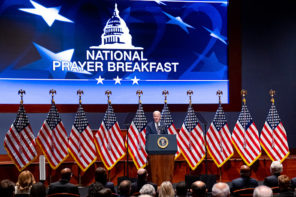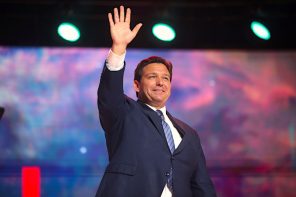D. Michael Lindsay, Faith in the Halls of Power: How Evangelicals Joined the American Elite
Oxford University Press, 2007
Sean McCloud, Divine Hierarchies: Class in American Religion and Religious Studies
University of North Carolina Press, 2007
D. Michael Lindsay opens his new book, Faith in the Halls of Power, with a story of the joining of two worlds at a posh New York event. Hosted by Rupert Murdoch “in one of Manhattan’s most celebrated ballrooms,” the event feted Rick Warren—evangelical preacher and publishing sensation—bringing together the seemingly disparate worlds of urban sophistication and folksy faith. “Do you know any of these evangelicals that are here?” a publishing house editor asked Lindsay. “I’m dying to meet one.”
The supposed evangelical/liberal divide is popularly parsed in a few different ways. One is the notion that it is simply religious faith and practice that defines the distinction; next is the focus on politics, with both left and right raising the specter of a well-organized, well-funded, highly successful “other” who threatens the values “we” hold dear. And finally there are the distinctions drawn from murkier cultural waters, things Americans find more difficult to talk about even when their pull is felt just as strongly. Differences in cultures and tastes, differences in regions and in education levels, differences in access to resources, both material and cultural—all inform the cultural imaginary that separates evangelicals from liberals. But the lack of a useful language of class makes it extremely difficult to articulate these differences, analyze their sources or even assess their accuracy.
Sean McCloud’s book Divine Hierarchies: Class in American Religion and Religious Studiesis a very useful effort at formulating that language for scholars and students of religion. Class matters, McCloud argues, but not in the ways that earlier academics thought. In order to think about class productively, he points to four ideas about class that need to be dispensed with. While class is certainly a structural reality, he notes that it is not always a felt affinity; the very idea of “class consciousness” might not be as useful as it might have once seemed. And while class as a concept has its roots in material conditions, he argues that it needs to be expanded to encompass discursive and representational dimensions that enable the identifications and distinctions fueling social differentiation. The reductionist view that sees class difference as the sole source of every social act and cultural product is also challenged, and thinkers about class and religion are called to task for limiting the study of class to the study of poor and working classes.
Having released some of the conceptual burdens class has been forced to bear, he then formulates a three-part understanding that emphasizes its centrality in games of social distinction played for access to material and cultural resources and power. The first considers class as a means groups use to separate themselves from others, often rendered lower or lesser. From this perspective, class is actually ascribed by others for the purposes of determining and fixing social boundaries; in writing about religion we see this in the association of certain kinds of religious expression with certain classes (ecstatic and expressive religion with lower classes and rational, restrained faith with middle classes). The second dimension of class he proposes is its use as a means of self-identification, a way that groups define themselves in relation to the rest of the social world. However, the means of representation and self-representation are not distributed equally, and the difference of class is, in part, a difference in how much control a given group has in articulating their identification in their own terms. Finally, he suggests that class plays a role in religious preferences and practices by shaping the opportunities and limits faced in religious expression. “The material circumstances of social class,” he writes “make one more or less available to affiliate with certain religious groups and try out particular religious ideas and practices.”
The remainder of the book is spent putting this scheme to work, analyzing both American religion and scholarship about American religion within its framework. One section surveys 20th-century religious studies, finding in it provocative illustration of class operating in his first sense. Highlighting three different discursive moments—eugenics discourse of the early decades, the social determinist turn between the wars, and deprivation theories of religious engagement of the mid-late century—he finds that each consideration of class works to maintain socio-cultural boundaries by rendering certain suspect groups perennial class-based others. He shows how scholars of religion have returned their fascinated gaze, again and again, to certain “usual suspects”: religious forms (Pentecostalism, Roman Catholicism, Fundamentalism, new religious movements) associated with socio-cultural groups (African Americans, immigrants, Native Americans, poor rural whites) far from the mainline-Protestant elites that more frequently populated the ranks of academic observers. Inadequate thinking about the idea of class, combined with class roles and assumptions that none could escape, resulted in analyses that reinforced existing socioeconomic hierarchies rather than interpreting them. In the final section he explores the constructive possibilities of his own model of class through historical analysis and ethnography. This work, like the whole book, is both very promising and somewhat frustrating in its suggestiveness; getting a taste of how class might be usefully reconfigured in thinking about religion made me hunger for a more developed, systematic account.
The value of the issues McCloud raises is evident in a book like Lindsay’s, where questions of religion, class, and the dynamics of social differentiation intertwine in a range of settings as seemingly contradictory as urbane publishing parties for popular preachers. As its title suggests, Faith in the Halls of Power: How Evangelicals Joined the American Elite looks at a very particular slice of evangelicals, a slice some liberals are loath to admit exists. Based on 360 interviews with evangelical leaders in business, politics, higher education and the arts, it examines the socio-cultural achievements evangelicals have attained in a relatively short period of time, and how these leaders see their positions of power and influence in relationship to their faith. One theme that recurs across the various sectors his interview subjects represent is the importance of groups and networks in generating a sense of evangelical cohesiveness, identity, and efficacy in the upper echelons of power. These groups range in size, form, and function, but all provide an opportunity for evangelicals to connect with those who share both their faith and their level of social and economic attainment. “The Fellowship,” which began in 1944 as a prayer breakfast for government and business leaders, is an example. Currently made up of senior government leaders, it is a place for believers from both political parties to develop their spiritual lives in a setting of their peers. “There is no other organization like the Fellowship,” Lindsay writes “in terms of its access or clout among the country’s leadership.” Compare that with Socrates in the City, a group of young, upwardly-mobile New York evangelicals who gather to socialize, listen to Christian intellectuals, and develop a faith life grounded in thought. Or the unnamed group of “very upper slice’” business executives who meet monthly for prayer and discussion. In each of these groups, class works in one way that McCloud suggests, by generating opportunities to access social networks and other nonmaterial resources that secure identity, generate power, and reinforce status.
Lindsay’s work sheds light on another question raised by McCloud: that of class distinction within a given faith community. The evangelicals interviewed by Lindsay are well aware of their elite positioning, and many, when seeking to impact the world for their faith, try to do so through elite strategies and institutions. Rather than giving to Christian colleges, for example, he finds that many evangelical philanthropists donate their resources toward evangelical-friendly spaces in the Ivy League; Christian culture workers aim their outreach to NPR listeners and PBS viewers. But part of aiming high is distancing from the low, and Lindsay astutely discusses how evangelical “cosmopolitans,” as he calls them, seek to distinguish themselves from their “populist” co-religionists and the subculture they share. Many interviewees were quick to inform him that they had never read the popular Left Behind series. “Not a single artist or entertainer,” he writes “referred to the evangelical subculture in positive terms. Derision was more likely. They used terms like ‘gross’, ‘cheesy,’ and ‘anemic.’ They regularly referred to the evangelical subculture as ‘baggage’ weighing them down on their way up the social ladder.” And a quarter of his subjects were reluctant to even identify as evangelicals, fearing association with particular political positions, but also with a subculture that does not share the tastes, habits, and perspectives of elites.
“Evangelical” itself is a contested term. Criticized by historian and Christian cultural critic D. G. Hart as a theologically empty category—constructed to serve the ambitions of 1940s culturally-engaged fundamentalists and the academic fashions of secular religious studies—the range of beliefs and practices that make up this unstable alliance of conservative Protestants have strong roots in two of McCloud’s “usual suspects”: Fundamentalists and Pentecostals. The increased visibility and apparent political successes of evangelicals in general, and the religious right in particular, have made this group central in the imaginary of academics and secular critics who are quick to appropriate some of the class-based tropes McCloud so astutely analyzes in discussing evangelical purposes and prospects.
Lindsay’s work explores head-on just why evangelicals make these observers more and more nervous. If McCloud is right that class-based representations in part serve to control elite fears generated by the dangerous masses, the evangelicals interviewed by Lindsay force the question of what happens when “they” aren’t as “they” as “we” thought they were. By looking at evangelicals who can’t be neatly confined by class-based “other-talk,” the book demonstrates the need for a language of class that will help make sense of the shifting terrain of religious identification and socio-political power. Lindsay found his publisher-friend an evangelical to talk to who graduated from the same Ivy League school that she did; what that might mean in a year where lines of political power will no doubt be significantly redrawn would be more adequately understood by taking class more fully into account.




